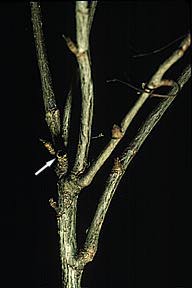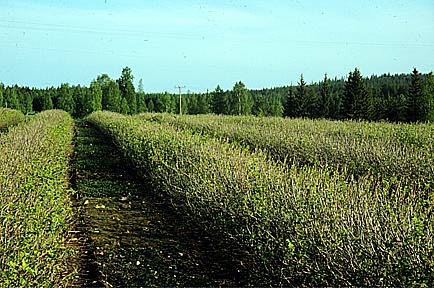Lampronia capitella
Currant shoot borer
Olle PellmyrAdult Characteristics
Depicted in Heath & Pelham-Clinton (1976). Wingspan 14-17 mm. Head ochreous yellow. Forewing dark purplish fuscous, with two basal spots fused into a diffuse cream-colored band from costa to hind edge, and isolated creamy spots on hind edge near tornus and opposite it on costa. Hindwings dark gray, sometimes with purplish tinge, darker toward tip.
Comparison with Similar Species
L. luzella is superficially similar, but differs in having two inner spots rather than a band.
Host, Oviposition, and Larval Feeding Habits
Eggs are laid in green fruits of Ribes spp.. Black currant (R. nigrum) is the premier host in northern Sweden, with orchards often being heavily attacked, and red currant (R. rubrum) is a less common host (S. Hellqvist, in litt.). In Britain, Heath & Pelham-Clinton report that red or white currant cultivars or gooseberry (R. grossularia) are used. Larvae feed during early instars inside maturing fruit, causing premature maturation, then abandons it and hibernates in a hibernaculum at the plant root. In spring, the larva enters a developing shoot of the host, usually causing its death. Pupation may occur inside the gallery or outside of it. The moth emerges in early summer.


Crater-like scar (arrow) on Ribes nigrum stem from past shoot destroyed by L. capitella; this scar is detectable for several years (S. Hellqvist, in litt.). Picture courtesy of Sven Hellqvist.
Geographic Distribution
From Britain eastward across Fennoscandia, central and northern continental Europe, and east to easternmost Siberia. The species has been introduced into North America.
Habitat
In settings with the host plants, including orchards, where it can cause considerable damage.


Ribes nigrum orchard devastated by L. capitella attack; Posjärv, northern Sweden, 1989. Picture courtesy of Sven Hellqvist.
References
Heath, J. & E.C. Pelham-Clinton. 1976. The moths and butterflies of Great Britain and Ireland, vol I: Incurvariidae. Blackwell Scientific Press and Curwen Press.
About This Page
Special thanks to S. Hellqvist for providing unpubl. host information.

University of Idaho, Moscow, Idaho, USA
Page copyright © 1996
 Page: Tree of Life
Lampronia capitella . Currant shoot borer.
Authored by
Olle Pellmyr.
The TEXT of this page is licensed under the
Creative Commons Attribution-NonCommercial License - Version 3.0. Note that images and other media
featured on this page are each governed by their own license, and they may or may not be available
for reuse. Click on an image or a media link to access the media data window, which provides the
relevant licensing information. For the general terms and conditions of ToL material reuse and
redistribution, please see the Tree of Life Copyright
Policies.
Page: Tree of Life
Lampronia capitella . Currant shoot borer.
Authored by
Olle Pellmyr.
The TEXT of this page is licensed under the
Creative Commons Attribution-NonCommercial License - Version 3.0. Note that images and other media
featured on this page are each governed by their own license, and they may or may not be available
for reuse. Click on an image or a media link to access the media data window, which provides the
relevant licensing information. For the general terms and conditions of ToL material reuse and
redistribution, please see the Tree of Life Copyright
Policies.
Citing this page:
Pellmyr, Olle. 1996. Lampronia capitella . Currant shoot borer. Version 01 January 1996 (under construction). http://tolweb.org/Lampronia_capitella/12357/1996.01.01 in The Tree of Life Web Project, http://tolweb.org/






 Go to quick links
Go to quick search
Go to navigation for this section of the ToL site
Go to detailed links for the ToL site
Go to quick links
Go to quick search
Go to navigation for this section of the ToL site
Go to detailed links for the ToL site